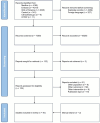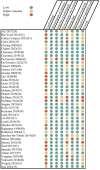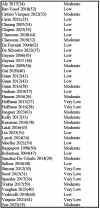Neuromonitoring modalities predicting neurological impairment in pediatric congenital heart disease: a systematic review
- PMID: 39744107
- PMCID: PMC11688251
- DOI: 10.3389/fneur.2024.1502762
Neuromonitoring modalities predicting neurological impairment in pediatric congenital heart disease: a systematic review
Abstract
The increased risk of neurodevelopmental impairment in children with congenital heart disease (CHD) has been established, but the search for targeted neurological predictors of adverse outcome is ongoing. This systematic review reports on the utility of three functional neuromonitoring modalities, Near-infrared Spectroscopy (NIRS), electroencephalography (EEG) and biochemical biomarkers, in predicting either clinical neurodevelopmental outcome or structural brain abnormalities after pediatric CHD surgery. Medline, Embase, CENTRAL, Web of Science, clinicaltrials.gov and ICTRP were systematically searched for eligible articles. Original research articles, written in English, published before November 2023 and reporting on perioperative NIRS, EEG or biomarkers and their association with clinical neurodevelopmental outcome or neuroimaging in children <17 years undergoing surgery for CHD were included. The search yielded 11,367 citations, of which 40 papers were included in the final review: sixteen articles (n = 908 cases) reported on NIRS, twelve (n = 1,163) on EEG and fifteen (n = 903) on biochemical biomarkers. Three papers reported on a combination of modalities. Median age at time of surgery was 9 (IQR 7-57) days. Postoperative MRI was performed before discharge at varying timepoints. Median age at clinical outcome assessment was 15 (IQR 12-24) months. Limited evidence supports an association of cerebral oxygen extraction, cerebral desaturation and cerebral autoregulation with outcome, but there was significant heterogeneity in results. Perioperative electroencephalographic ictal discharges and abnormal background were associated with impaired neurological outcome and abnormal neuroimaging. Numerous biochemical biomarkers have been reported but showed no consistent relationship with outcome, except for lactate, which could serve as a predictor of poor outcome. There is a need for larger homogeneous cohorts of children with CHD to determine which perioperative modalities might serve as predictors of neurodevelopmental outcome or neuroimaging abnormalities.
Systematic review registration: http://www.crd.york.ac.uk/PROSPERO, CRD42023479344.
Keywords: biomarkers; congenital heart disease; electroencephalography; near-infrared spectroscopy; neurodevelopment; neuroimaging; neuromonitoring.
Copyright © 2024 Van Loo, Cools, Dereymaeker and Jansen.
Conflict of interest statement
The authors declare that the research was conducted in the absence of any commercial or financial relationships that could be construed as a potential conflict of interest.
Figures
Similar articles
-
The clinical effects of cerebral near-infrared spectroscopy monitoring (NIRS) versus no monitoring: a protocol for a systematic review with meta-analysis and trial sequential analysis.Syst Rev. 2021 Apr 16;10(1):111. doi: 10.1186/s13643-021-01660-2. Syst Rev. 2021. PMID: 33863369 Free PMC article.
-
Neuromonitoring, neuroimaging, and neurodevelopmental follow-up practices in neonatal congenital heart disease: a European survey.Pediatr Res. 2023 Jan;93(1):168-175. doi: 10.1038/s41390-022-02063-2. Epub 2022 Apr 12. Pediatr Res. 2023. PMID: 35414671 Free PMC article.
-
Utility of Brain Injury Biomarkers in Children With Congenital Heart Disease Undergoing Cardiac Surgery.Pediatr Neurol. 2023 Nov;148:44-53. doi: 10.1016/j.pediatrneurol.2023.06.024. Epub 2023 Jul 6. Pediatr Neurol. 2023. PMID: 37657124 Review.
-
Cerebral tissue oxygenation index and lactate at 24 hours postoperative predict survival and neurodevelopmental outcome after neonatal cardiac surgery.Congenit Heart Dis. 2017 Mar;12(2):188-195. doi: 10.1111/chd.12426. Epub 2016 Nov 10. Congenit Heart Dis. 2017. PMID: 27862979
-
Non-Invasive Multimodal Neuromonitoring in Non-Critically Ill Hospitalized Adult Patients With COVID-19: A Systematic Review and Meta-Analysis.Front Neurol. 2022 Apr 14;13:814405. doi: 10.3389/fneur.2022.814405. eCollection 2022. Front Neurol. 2022. PMID: 35493827 Free PMC article.
Cited by
-
Cerebral Near-Infrared Spectroscopy and Electrical Cardiometry During Endotracheal Suction in Ventilated Infants Following Surgery: A Feasibility Study.Life (Basel). 2025 May 31;15(6):901. doi: 10.3390/life15060901. Life (Basel). 2025. PMID: 40566554 Free PMC article.
-
Spectral EEG in Congenital Heart Disease: A Case-Control Study in Infants Undergoing Cardiac Surgery.Pediatr Cardiol. 2025 Jul 25. doi: 10.1007/s00246-025-03958-7. Online ahead of print. Pediatr Cardiol. 2025. PMID: 40711558
References
-
- Dijkhuizen EI, de Munck S, de Jonge RCJ, Dulfer K, van Beynum IM, Hunfeld M, et al. . Early brain magnetic resonance imaging findings and neurodevelopmental outcome in children with congenital heart disease: a systematic review. Dev Med Child Neurol. (2023) 65:1557–72. doi: 10.1111/dmcn.15588 - DOI - PubMed
Publication types
LinkOut - more resources
Full Text Sources




